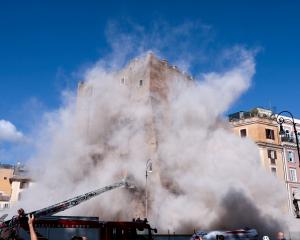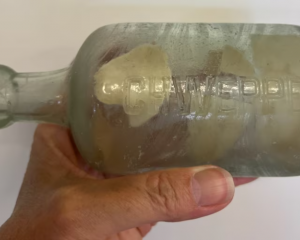United States President Donald Trump showed a screenshot of Reuters video taken in the Democratic Republic of Congo as part of what he falsely presented as evidence of mass killings of white South Africans.
"These are all white farmers that are being buried," said Trump, holding up a print-out of an article accompanied by the picture during a contentious Oval Office meeting with South African President Cyril Ramaphosa on Wednesday.
In fact, the video, published by Reuters on February 3 this year and subsequently verified by the news agency's fact check team, showed humanitarian workers lifting body bags in the Congolese city of Goma.
The image was pulled from Reuters footage shot following deadly battles with Rwanda-backed M23 rebels.
The blog post showed to Ramaphosa by Trump during the White House meeting was published by American Thinker, a conservative online magazine, about conflict and racial tensions in South Africa and Congo.
The post did not caption the image but identified it as a "YouTube screen grab" with a link to a video news report about Congo on YouTube, which credited Reuters.

The White House did not respond to a request for comment.
Andrea Widburg, managing editor at American Thinker and the author of the post in question, wrote in reply to a Reuters query that Trump had "misidentified the image."
She added, however, that the post, which referred to what it called Ramaphosa's "dysfunctional, race-obsessed Marxist government", had "pointed out the increasing pressure placed on white South Africans."
The footage from which the picture was taken shows a mass burial following an M23 assault on Goma, filmed by Reuters video journalist Djaffar Al Katanty.
"That day, it was extremely difficult for journalists to get in ... I had to negotiate directly with M23 and coordinate with the ICRC to be allowed to film," Al Katanty said. "Only Reuters has video."
Al Katanty said seeing Trump holding the article with the screengrab of his video came as a shock.
"In view of all the world, President Trump used my image, used what I filmed in DRC to try to convince President Ramaphosa that in his country, white people are being killed by Black people," Al Katanty said.
Ramaphosa praised for composure
Ramaphosa visited Washington this week to try to mend ties with the US after persistent criticism from Trump in recent months over South Africa's land laws, foreign policy, and alleged bad treatment of its white minority, which South Africa denies.
Trump interrupted the televised meeting with Ramaphosa to play a video, which he said showed evidence of genocide of white farmers in South Africa. This conspiracy theory, which has circulated in far-right chat rooms for years, is based on false claims.
Trump then proceeded to flip through printed copies of articles that he said detailed murders of white South Africans, saying "death, death, death, horrible death".
Facing a barrage of debunked claims from Trump that white people were being persecuted in his country, Ramaphosa remained composed, pushed back politely and even tried to joke with the president.
Ramaphosa may have drawn on his experience as the African National Congress's lead negotiator in talks that led to the peaceful end of apartheid in 1994 during Wednesday's televised confrontation in the Oval Office.
"His conduct was in keeping with the proud diplomatic tradition of President Nelson Mandela," said Ramaphosa's party the African National Congress, invoking the legacy of the revered liberation struggle leader and first black president.
Repeatedly interrupted by Trump, Ramaphosa calmly challenged claims that minority Afrikaners were the targets of a "white genocide". The once fringe theory has been exponentially amplified by Trump and his South African-born ally Elon Musk.
"There is criminality in our country. People who do get killed, unfortunately, through criminal activity are not only white people. Majority of them are black people," said Ramaphosa.
The way he handled Trump's onslaught was mostly drawing praise back home on Thursday.
"President Ramaphosa did well to maintain a calm demeanour and he did well to stick to the facts as close as possible," said author Pieter du Toit.
Political analyst Ralph Mathekga said Ramaphosa kept sight of the bigger picture and did not take the bait. "There was never a sense of arrogance on the side of Ramaphosa. He managed his emotions in a tactful way."
Ramaphosa would have been braced for a hostile reception given Trump has cut aid to South Africa, threatened it with a 30% trade tariff under his "Liberation Day" regime, expelled its ambassador and offered refuge to Afrikaners based on claims of persecution Ramaphosa's government says are unfounded.
Expectations of what the visit might achieve were therefore measured.
"Few of those who watched the spectacle would have been left with the impression that SA-US relations are set to improve," said Louw Nel, senior political analyst at Oxford Economics.
"The South African president ... is considered a master negotiator and his ability to charm audiences is well-known. But even he must be wondering if it was wise visiting the White House at this time," he wrote in a note.












